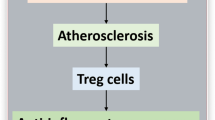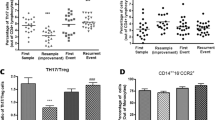Abstract
Objective and design
We investigated a possible imbalance between T helper (Th)17 and CD4+ CD25+ forkhead/winged helix transcription factor (Foxp3) T regulatory (Treg) cells in patients with carotid artery plaques.
Material or subjects
From November 2009 to September 2010, we enrolled 126 males and 104 females with mean age 68.24 ± 6.71 years.
Treatment
Based on carotid artery sonography, the 230 subjects were categorized into three groups: plaque negative; stable plaques; and unstable plaques.
Methods
Th17 and Treg cell frequencies, relevant plasma cytokines (IL-17, IL-6, IL-23, and TNF-α), and RORγt mRNA levels were determined.
Results
Compared to plaque negative, Th17 cells, Th17-related cytokines (IL-17, IL-6, IL-23, and TNF-α), and RORγt mRNA levels were higher with stable plaques, and highest with unstable plaques. The opposite trend was found for Treg cells, Treg-related cytokines (IL-10 and TGF-β1), and Foxp3 mRNA. Th17 cell frequencies were significantly negatively correlated with Treg cell frequencies.
Conclusions
Our investigation demonstrated that there is a Th17/Treg functional imbalance in patients with unstable carotid atherosclerotic plaques. Th17 cells may promote atherogenesis, while Treg cells may have a protective role against atherosclerosis plaques. An imbalance of Th17/Treg cells may offer a new direction for the treatment of atherosclerosis.





Similar content being viewed by others
References
Libby P. Inflammation in atherosclerosis. Nature. 2002;420:868–74.
Hansson GK, Libby P. The immune response in atherosclerosis: a double-edged sword. Nat Rev Immunol. 2006;6:508–19.
de Boer OJ, Becker AE, van der Wal AC. T lymphocytes in atherogenesis—functional aspects and antigenic repertoire. Cardiovasc Res. 2003;60:78–86.
Daugherty A, Rateri DL. T Lymphocytes in atherosclerosis: the ying-yang of Th1 and Th2 influence on lesion formation. Circ Res. 2002;90:1039–40.
Taleb S, Tedgui A, Mallat Z. Adaptive T cell immune responses and atherogenesis. Curr Opin Pharmacol. 2010;10:197–202.
Frostegard J, Ulfgren AK, Nyberg P, Hedin U, Swedenborg J, Andersson U, et al. Cytokine expression in advanced human atherosclerotic plaques: dominance of pro-inflammatory (Th1) and macrophage-stimulating cytokines. Atherosclerosis. 1999;145:33–43.
Cheng X, Chen Y, Xie JJ, Yao R, Yu X, Liao MY, et al. Suppressive oligodeoxynucleotides inhibit atherosclerosis in ApoE(-/-) mice through modulation of Th1/Th2 balance. J Mol Cell Cardiol. 2008;45:168–75.
Methe H, Brunner S, Wiegand D, Nabauer M, Koglin J, Edelman ER. Enhanced T-helper-1 lymphocyte activation patterns in acute coronary syndromes. J Am Coll Cardiol. 2005;45:1939–45.
Cheng X, Liao YH, Ge H, Li B, Zhang J, Yuan J, et al. TH1/TH2 functional imbalance after acute myocardial infarction: coronary arterial inflammation or myocardial inflammation. J Clin Immunol. 2005;25:246–53.
Harrington LE, Hatton RD, Mangan PR, Turner H, Murphy HTL, Murphy KM, et al. Interleukin 17-producing CD4+ effector T cells develop via a lineage distinct from the T helper type 1 and 2 lineages. Nat Immunol. 2005;6:1123–32.
Sauer S, Bruno L, Hertweck A, Finlay D, Leleu M, Spivakov M, Knight ZA, Cobb BS, Cantrell D, O’Connor E, Shokat KM, Fisher AG, Merkenschlager M. T cell receptor signaling controls Foxp3 expression via PI3K, Akt, and mTOR. Proc Natl Acad Sci USA. 2008;105:7797–802.
Arun KV, Talwar A, Kumar TSS. T-helper cells in the etiopathogenesis of periodontal disease: a mini review. J Indian Soc Periodontol. 2011;15:4–10.
Zhang J, Hua G, Zhang X, Tong R, Du X, Li Z, et al. Regulatory T cells/T-helper cell 17 functional imbalance in uraemic patients on maintenance haemodialysis: a pivotal link between microinflammation and adverse cardiovascular events. Nephrology. 2010;15:33–41.
Weaver CT, Hatton RD, Mangan PR, Harrington LE. IL-17 family cytokines and the expanding diversity of effector T cell lineages. Annu Rev Immunol. 2007;25:821–52.
Bettelli E, Oukka M, Kuchroo VK. T(H)-17 cells in the circle of immunity and autoimmunity. Nat Immunol. 2007;8:345–50.
Ivanov II, McKenzie BS, Zhou L, Tadokoro CE, Lepelley A, Lafaille JJ, Cua DJ, Littman DR. The orphan nuclear receptor RORgammat directs the differentiation program of pro-inflammatory IL-17+ T helper cells. Cell. 2006;126:1121–33.
Taleb S, Tedgui A, Mallat Z. Interleukin-17: friend or foe in atherosclerosis? Curr Opin Lipidol. 2010;21:404–8.
Iwakura Y, Ishigame H, Saijo S, Nakae S. Functional specialization of interleukin-17 family members. Immunity. 2011;34:149–62.
Muller YD, Seebach JD, Bühler LH, Pascual M, Colshayan D. Transplantation tolerance: clinical potential of regulatory T cells. Self-Nonself. 2011;2:26–34.
Gavin MA, Rasmussen JP, Fontenot JD, Vasta V, Manganiello VC, Beavo JA, et al. Foxp3-dependent programme of regulatory T-cell differentiation. Nature. 2007;44:771–5.
Sakaguchi S. Regulatory T cells: history and perspective. Methods Mol Biol. 2011;707:3–17.
Venuprasad K, Kong YC, Farrar MA. Control of Th2-mediated imflammation by regulatory T cells. Am J Pathol. 2010;177:525–31.
Sakaguchi S. Regulatory T cells: key controllers of immunologic self-tolerance. Cell. 2000;101:455–8.
Kim JM, Rasmussen JP, Rudensky AY. Regulatory T cells prevent catastrophic autoimmunity throughout the lifespan of mice. Nat Immunol. 2007;8:191–7.
Yang J, Chu YW, Yang X, Gao K, Zhu LB, Yang XR, Wan LL, Li M. Th17 and natural Treg cell population dynamics in systemic lupus erythematosus. Arthritis Rheum. 2009;60:1472–83.
Oukka M. Interplay between pathogenic Th17 and regulatory T cells. Ann Rheum Dis. 2007; 66 (Suppl III):87–90.
Locke NR, Patterson SJ, Hamilton MJ, Sly LM, Krystal G, Lewvings MK. SHIP regulates the reciprocal development of T regulatory and Th17 cells. J Immunol. 2009;183:975–83.
Pejnovic N, Vratimos A, Lee SH, Popadic D, Takeda K, Akira S, Chan WL. Increased atherosclerotic lesions and Th17 in interleukin-18 deficient apolipoprotein E-knockout mice fed high-fat diet. Mol Immunol. 2009;47:37–45.
Smith E, Prasad KM, Butcher M, Dobrian A, Kolls JK, Lev K, Galkina E. Blockade of interleukin-17A results in reduced atherosclerosis in apolipoprotein E-deficient mice. Circulation. 2010;121:1746–55.
Xie JJ, Wang J, Tang TT, Chen J, Gao XL, Yuan J, Zhou ZH, Liao MY, Yao R, Yu X, Wang K, Cheng Y, Liao YH, Cheng X. The Th17/Treg functional imbalance during atherogenesis in ApoE-/- mice. Cytokine. 2010;49:185–93.
Li Q, Wang Y, Chen K, Zhou Q, Wei W, Wang Y. The role of oxidized low-density lipoprotein in breaking peripheral Th17/Treg balance in patients with acute coronary syndrome. Biochem Biophys Res Commun. 2010;394:836–42.
Cheng X, Yu X, King YJ, Fu QQ, Xie JJ, Tang TT, Yao R, Chen Y, Liao YH. The Th17/Treg imbalance in patients with acute coronary syndrome. Clin Immunol. 2008;127:89–97.
Salonen JT, Salonen R. Ultrasound B-mode imaging in observational studies of atherosclerotic progression. Circulation. 1993;87(2):S56–65.
Preston E, Ellis MR, Kulinskaya E, Davies AH, Brown EA. Association between carotid artery intima-media thickness and cardiovascular risk factors in CKD. Am J Kidney Dis. 2005;46:856–62.
Touboul PJ, Hennerici MG, Meairs S, et al. Mannheim carotid intima-media thickness consensus (2004–2006). An update on behalf of the Advisory Board of the 3rd and 4th Watching the Risk Symposium, 13th and 15th European Stroke Conferences, Mannheim, Germany, 2004, and Brussels, Belgium, 2006. Cerebrovasc Dis 2007; 23:75–80.
Suh SY, Han SW, Kim SH, Kim HJ, Chung SM, Ryu KH. Carotid intima-media thickness and plaque as a predictor for ischemic etiology in patients with severe left ventricular systolic dysfunction. Korean Circ J. 2010;40:665–70.
Reilly LM, Lusby RJ, Hughes L, Ferrell LD, Stoney RJ, Ehrenfeld WK. Carotid plaque histology in real time ultrasonography. Am J Surg. 1983;146:188–93.
Hansson GK. Inflammation, atherosclerosis, and coronary artery disease. N Engl J Med. 2005;352:1685–95.
Wanderlaan PA, Reardon CA. Thematic review series: the immune system and atherogenesis. The unusual suspects: an overview of the minor leukocyte populations in atherosclerosis. J Lipid Res. 2005;46:829–38.
Wan YY, Flavell RA. Regulatory T-cell functions are subverted and converted owing to attenuated Foxp3 expression. Nature. 2007;445:766–70.
Chen S, Crother TR, Arditi M. Emerging role of IL-17 in atherosclerosis. J Innate Immunol. 2010;2:325–33.
Miyamoto M, Prause O, Sjostrand M, Laan M, Lotvall J, Linden A. Endogenous IL-17 as a mediator of neutrophil recruitment caused by endotoxin exposure in mouse airways. J Immunol. 2003;170:4665–72.
Xu F, Ji J, Li L, Chen R, Hu WC. Adventitial fibroblasts are activated in the early stages of atherosclerosis in the apolipoprotein E knockout mouse. Biochem Biophys Res Commun. 2007;352:681–8.
Hoogeveen RC, Morrison A, Boerwinkle E, Miles JS, Rhodes CE, Sharrett AR, Ballantyne CM. Plasma MCP-1 level and risk for peripheral arterial disease and incident coronary heart disease: Atherosclerosis Risk in Communities study. Atherosclerosis. 2005;183:301–7.
von Vietinghoff S, Ley K. Interleukin 17 in vascular inflammation. Cytokine Growth Factor Rev. 2010;21:463–9.
Erbel C, Chen L, Bea F, Wangler S, Celik S, Lasitschka F, Wang Y, Böckler D, Katus HA, Dengler TJ. Inhibition of IL-17A attenuates atherosclerotic lesion development in ApoE-deficient mice. J Immunol. 2009;183:8167–75.
Taleb S, Romain M, Ramkhelawon B, Uyttenhove C, Pasterkamp G, Herbin O, Esposito B, Perez N, Yasukawa H, Van Snick J, Yoshimura A, Tedgui A, Mallat Z. Loss of SOCS3 expression in T cells reveals a regulatory role for interleukin-17 in atherosclerosis. J Exp Med. 2009;206:2067–77.
Wilson NJ, Boniface K, Chan JR, McKenzie BS, Blumenschein WM, Mattson JD, Basham B, Smith K, Chen T, Morel F, Lecron JC, Kastelein RA, Cua DJ, McClanahan TK, Bowman EP, de Waal Malefyt R. Development, cytokine profile and function of human interleukin 17-producing helper T cells. Nat Immunol. 2007;8:950–7.
Chen Z, Tato CM, Muul L, Laurence A, O’Shea JJ. Distinct regulation of interleukin-17 in human T helper lymphocytes. Arthritis Rheum. 2007;56:2936–46.
Csiszar A, Ungvari Z. Synergistic effects of vascular IL-17 and TNF-a may promote coronary artery disease. Med Hypotheses. 2004;63:696–8.
Sakaguchi S, Setoguchi R, Yagi H, Nomura T. Naturally arising Foxp3-expressing CD25+ CD4+ regulatory T cells in self-tolerance and autoimmune disease. Curr Top Microbiol Immunol. 2006;305:51–66.
Schubert LA, Jeffery E, Zhang Y. Scurfin (FOXP3) acts as a repressor of transcription and regulates T cell activation. Biol Chem. 2001;276:37672–9.
George J. Mechanisms of disease: the evolving role of regulatory T cells in atherosclerosis. Nat Clin Pract Cardiovasc Med. 2008;5:531–40.
Platten M, Youssef S, Hur EM, Ho PP, Han MH, Lanz TV, Phillips LK, Goldstein MJ, Bhat R, Raine CS, et al. Blocking angiotensin-converting enzyme induces potent regulatory T cells and modulates TH1- and TH17-mediated autoimmunity. Proc Natl Acad Sci USA. 2009;106:14948–53.
Tao R, de Zoeten EF, Ozkaynak E, Chen C, Wang L, Porrett PM, Li B, Turka LA, Olson EN, Greene MI, et al. Deacetylase inhibition promotes the generation and function of regulatory T cells. Nat Med. 2007;13:1299–307.
Mor A, Planer D, Luboshits G, Afek A, Metzger S, Chajek-Shaul T, et al. Role of naturally occurring CD4 + CD25 + regulatory T cells in experimental atherosclerosis. Arterioscler Thromb Vasc Biol. 2007;27:893–900.
Ait-Oufella H, Salomon BL, Potteaux S, Robertson AK, Gourdy P, Zoll J, et al. Natural regulatory T cells control the development of atherosclerosis in mice. Nat Med. 2006;12:178–80.
Acknowledgments
This work was supported by the Natural Science Foundation of Shandong Province, China (No. ZR2009CL029 and NO. ZR2011HQ053), and by the Shandong Science and Technology Development Program, China (No. 2011GSF11822).
Conflict of interest
The authors have no financial conflicts of interest.
Author information
Authors and Affiliations
Corresponding author
Additional information
Responsible Editor: Andras Falus.
Rights and permissions
About this article
Cite this article
Liu, Zd., Wang, L., Lu, Fh. et al. Increased Th17 cell frequency concomitant with decreased Foxp3+ Treg cell frequency in the peripheral circulation of patients with carotid artery plaques. Inflamm. Res. 61, 1155–1165 (2012). https://doi.org/10.1007/s00011-012-0510-2
Received:
Revised:
Accepted:
Published:
Issue Date:
DOI: https://doi.org/10.1007/s00011-012-0510-2




